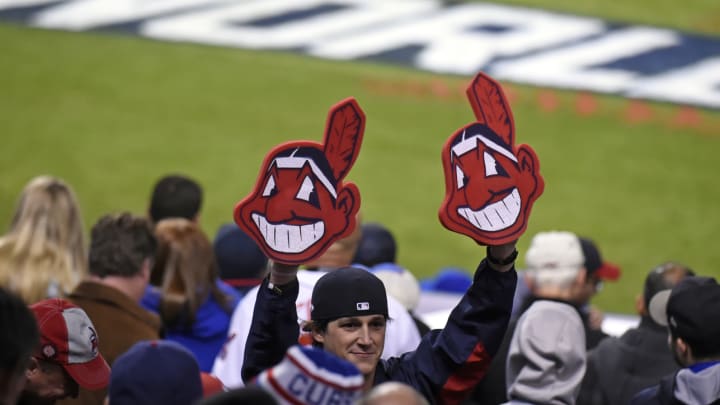How Chief Wahoo has evolved over time

Chief Wahoo—a racist caricature of a Native American—remains the logo of the Cleveland Indians despite a campaign by some to get the baseball franchise to finally do away with the controversial emblem.
Other sports franchises, most prominently the Washington Redskins, use Native American mascots. But the Indians' logo stands out for its blatant offensiveness. And so for a number of years, controversy has followed Chief Wahoo. Recently, a Native American activist asked a judge to ban the name and logo before Game 3 of the ALCS. Fans have shown up to World Series games at Progressive Field with red face paint and headdresses, a clear appropriation of American Indian culture. The Cleveland American Indian Movement has called for a protest against the logo.
While Chief Wahoo has received the most attention, the Indians team name has also been the subject of debate. Earlier this month, Toronto Blue Jays announcer Jerry Howarthreminded listeners that he would refuse to use the word “Indians” in his American League Championship Series broadcast.
But the debate largely centers on Chief Wahoo. Here's a look at how the controversial logo has evolved over time.
Newspaper origins
Chief Wahoo came into existence in 1932 when the Cleveland Plain Dealer featured a caricature of a Native American with shaded skin and a pointy nose drawn by Fred George Reinert. The character came to be known as “The Little Indian” and was featured in the paper's coverage of the team. In a way, it was an earlier version of an emoji. His image popped up throughout the sports pages and was used to express feelings of happiness during winning streaks or dismay during rainouts. Reinert’s Indians drawings went on for about 30 years before the Indians added a more animated caricature as their official team logo.
The first Chief
Remember, in the 1940s, Chief Wahoo was somehow worse. (via @sportslogosnet) pic.twitter.com/PqCVPnMtr2
— jesse spector (@jessespector) October 7, 2016
In 1947, Indians owner Bill Veeck commissioned 17-year-old Walter Goldbach to design team's new logo. The first design showed a red–skinned Native American with a cartoon head much bigger than his body. The character is batting and grinning with a red feather sticking out the back of his black hair. An alternate logo that was used from 1947 was less red but featured many of the same characteristics.
Sportswriters came up with the name “Chief Wahoo” over time. (It also became a nickname for pitcher Allie Reynolds, a member of the Muscogee (Creek) nation.) Goldbach initially struggled with his assignment and believed the name did not quite match up to his drawing, since a chief would feature more feathers in his headdress. The original Wahoo only had one feather.
Championship chief
After the Cleveland #Indians won the #WorldSeries in 1948 they added a crown to their "Chief Wahoo" logo
— SportsLogos.Net (@sportslogosnet) October 25, 2016
See it: https://t.co/FFkTqWXu4x pic.twitter.com/Zmo1fhabz3
Before winning their second and most recent World Series, the Indians changed their logo to a similar image of Chief Wahoo facing straight ahead and an all-red feather sticking out of his head. A crown was added at times from 1949 to 1955 after the team celebrated their World Series win.
• Time for Indians, MLB to get rid of ridiculous and offensive Chief Wahoo
Downplaying Chief Wahoo
In 1951, the Indians made a change to Chief Wahoo, giving his face a smaller nose and red skin. This version of the logo is very close to the one that has been used by the team in recent years. The color of the logo's outline has changed periodically over the last 60 or so years.
In a city that has lost the Browns and LeBron James for periods of time, Chief Wahoo has been one of the constants of Cleveland sports. But despite the logo's blatantly offensive nature, the Indians have continued using Chief Wahoo, though the team has made several slight efforts to downplay the logo. In 2009, Chief Wahoo was taken off the team’s batting helmets while on the road. Just before the 2016 season, the Indians announced that Chief Wahoo would be demoted from their primary logo and that they would opt for the block “C” logo on their baseball caps. Chief Wahoo remains on the sleeves of player jerseys.
“(We have) no plans to get rid of Chief Wahoo,” owner Paul Dolan told the Plain Dealer at the time. “It is part of our history and legacy.”
That "legacy" was on the caps of players this week during Games 1 and 2 of the World Series.

An avid runner, Chris Chavez covers track and field, marathons and the Olympics for Sports Illustrated.